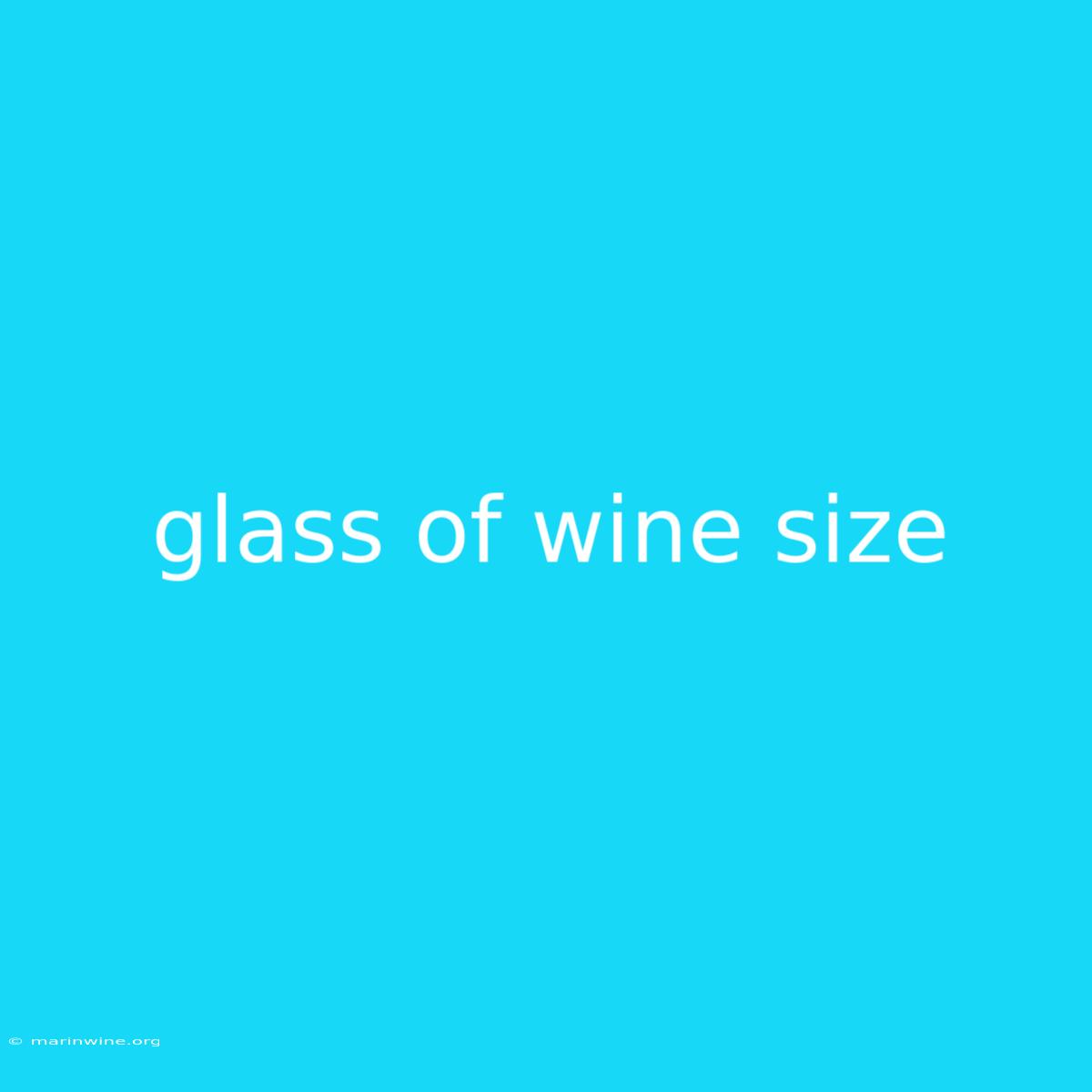The Perfect Pour: A Guide to Glass of Wine Size
Have you ever wondered if your glass of wine is the right size? You're not alone! The size of your wine glass can significantly impact your enjoyment and even your consumption.
Why It Matters: Understanding the ideal glass size for different types of wine can elevate your wine tasting experience. It's about enjoying the nuances of the wine's aromas, flavors, and texture in the right proportions.
Key Takeaways of Wine Glass Size:
| Feature | Description |
|---|---|
| Glass Size | Affects the wine's temperature, aeration, and the concentration of aromas and flavors. |
| Shape and Design | Enhances the wine's bouquet, directs the flow of the wine to the palate, and influences the taste. |
| Material | Influences the temperature of the wine and the clarity of its appearance. |
| Size and Shape Matching | Optimizes the wine's presentation and your tasting experience. |
Glass of Wine Size: Exploring the Perfect Pour
The Importance of Size
The size of a wine glass is crucial for the optimal enjoyment of the wine. A small glass, such as a 5-ounce flute or a 6-ounce white wine glass, is best for delicate white wines, as it concentrates the aromas and keeps the wine chilled. A larger glass, such as a 12-ounce red wine glass or a 14-ounce Bordeaux glass, is better suited for full-bodied red wines, allowing for proper aeration and releasing their complex flavors.
The Impact of Shape and Design
The shape and design of a wine glass play a crucial role in how you experience the wine. For example, a Bordeaux glass is designed to concentrate the aromas of full-bodied red wines, while a Burgundy glass is more rounded and allows for more aeration, enhancing the fruitiness and complexity of Pinot Noir.
Choosing the Right Material
Glass is the most common material for wine glasses, but crystal is also popular. Crystal is known for its clarity and brilliance, while glass is less expensive and more durable. The material also impacts the temperature of the wine, with crystal tending to be more insulating than glass.
Matching Size and Shape to Wine Style
White Wines:
- Small, narrow glasses: Ideal for preserving the wine's chill and concentrating the aromas.
- Examples: Chardonnay, Sauvignon Blanc, Pinot Grigio, Riesling
Red Wines:
- Larger, wider glasses: Allow for greater aeration and the release of complex flavors.
- Examples: Cabernet Sauvignon, Merlot, Syrah, Pinot Noir, Burgundy
Sparkling Wines:
- Flute glasses: Preserve the fizz and highlight the delicate aromas.
- Examples: Champagne, Prosecco, Cava
Beyond the Basics: Exploring the Role of Glassware
- Decanters: Used to aerate red wines, particularly older vintages.
- Snifters: Enhance the aromas of brandy and other fortified wines.
- Tumblers: Suitable for cocktails and mixed drinks.
Understanding Glass of Wine Size: Key Takeaways
- The size and shape of the wine glass influence the wine's temperature, aeration, and taste.
- Smaller glasses are best for lighter-bodied wines, while larger glasses are better for full-bodied wines.
- Matching the glass size and shape to the wine style enhances the tasting experience.
FAQ for Glass of Wine Size
Q: How much wine should I pour into a glass?
A: A standard serving of wine is 5 ounces, which is typically the amount that fits in a small white wine glass. However, you can pour more or less depending on your preference and the size of the glass.
Q: Is there a specific rule about the size of the wine glass I should use?
A: While there are no strict rules, using a glass appropriate for the type of wine enhances the experience.
Q: Can I use any glass for wine?
A: While any glass will do, using the right glass will significantly elevate your wine-drinking experience.
Q: What is the difference between a Bordeaux and Burgundy glass?
A: A Bordeaux glass has a taller, narrower bowl designed to concentrate the aromas of full-bodied red wines. A Burgundy glass has a wider, more rounded bowl that allows for more aeration, enhancing the fruitiness and complexity of Pinot Noir.
Q: What is the best material for wine glasses?
A: Both crystal and glass are popular materials for wine glasses. Crystal is known for its clarity and brilliance, while glass is less expensive and more durable.
Tips by Glass of Wine Size
- Choose a glass with a wide bowl for full-bodied red wines to allow for proper aeration.
- Opt for a smaller glass for delicate white wines to concentrate the aromas and keep the wine chilled.
- Consider the shape of the glass when choosing a wine glass, as it can impact how you experience the wine.
- Use a decanter for older red wines to allow them to breathe and release their complex flavors.
- Don't overfill the glass to allow for proper swirling and tasting.
Summary by Glass of Wine Size
This article explored the importance of glass of wine size and how it can impact the taste and enjoyment of wine. By understanding the principles of wine glass size, you can enhance your wine-drinking experience and appreciate the nuances of each wine. Remember to choose a glass appropriate for the type of wine you are enjoying and let the aromas and flavors dance on your palate.
Closing Message
The size of your wine glass may seem like a small detail, but it can make a big difference in how you experience your wine. So the next time you raise a glass, consider the size and shape, and enjoy the nuanced flavors that a well-chosen glass can bring to your wine experience.

